The Veterinary Rehabilitation Services Market is estimated to be valued at USD 1028.0 million in 2025 and is projected to reach USD 2447.1 million by 2035, registering a compound annual growth rate (CAGR) of 9.1% over the forecast period.
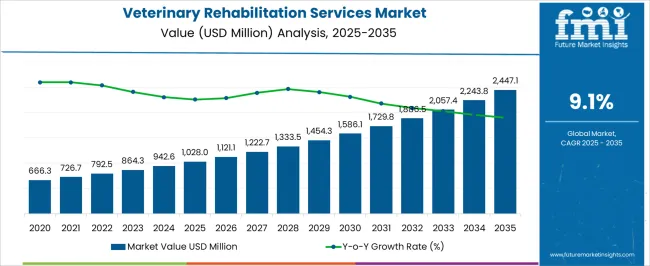
| Metric | Value |
|---|---|
| Veterinary Rehabilitation Services Market Estimated Value in (2025 E) | USD 1028.0 million |
| Veterinary Rehabilitation Services Market Forecast Value in (2035 F) | USD 2447.1 million |
| Forecast CAGR (2025 to 2035) | 9.1% |
The veterinary rehabilitation services market is expanding steadily as pet owners become more aware of advanced care options to enhance the recovery and quality of life of their animals. Growing expenditure on pet health, coupled with the humanization of companion animals, is fueling demand for structured rehabilitation programs.
Advancements in diagnostic tools and treatment protocols have enabled more accurate assessment and targeted therapies for a wide range of conditions. Increasing referrals from veterinarians for rehabilitation as a complementary treatment is also contributing to the market’s growth.
The integration of physical therapies into standard veterinary practices is enhancing outcomes and promoting faster recovery from injury, surgery, and chronic conditions. As access to specialized services continues to rise and pet owners seek proactive and preventive care options, the veterinary rehabilitation services market is poised for sustained development.
The market is segmented by Animal Type, Therapy Type, Indication, and End Use and region. By Animal Type, the market is divided into Companion Animals, Wildlife Animals, and Production Animals. In terms of Therapy Type, the market is classified into Therapeutic Exercises, Manual Therapy, Hydrotherapy, Hot & Cold Therapies, Electrotherapies, Acupuncture, Shockwave Therapy, and Other Therapies. Based on Indication, the market is segmented into Post-Surgery, Traumatic Injuries, Acute & Chronic Diseases, Developmental Abnormalities, and Other Indications. By End Use, the market is divided into Veterinary Rehab Centers & Hospitals, Rescue & Shelter Homes, Rehab Sanctuary, and Others. Regionally, the market is classified into North America, Latin America, Western Europe, Eastern Europe, Balkan & Baltic Countries, Russia & Belarus, Central Asia, East Asia, South Asia & Pacific, and the Middle East & Africa.
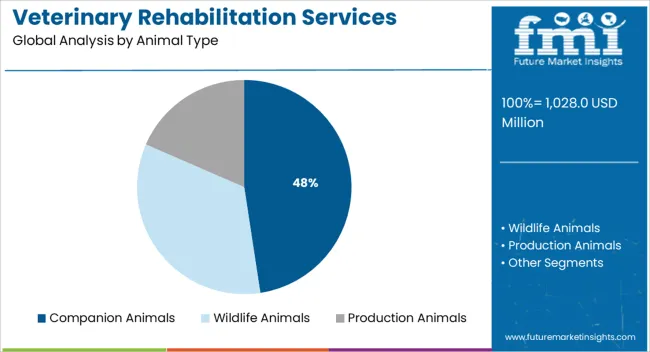
The companion animals segment is projected to account for 47.60% of the total market share by 2025 within the animal type category, making it the leading segment. This is driven by the increasing number of household pets and growing awareness among pet owners about physical therapy benefits in improving mobility, reducing pain, and enhancing overall wellness.
Companion animals, especially dogs and cats, frequently undergo rehabilitation to manage age-related degeneration, neurological issues, and injury recovery. Rising adoption of pet insurance that includes rehabilitation coverage and the growing availability of specialized veterinary care centers have further supported this segment’s dominance.
As pet care shifts toward long-term wellness and preventive solutions, companion animals continue to lead the demand for veterinary rehabilitation services.
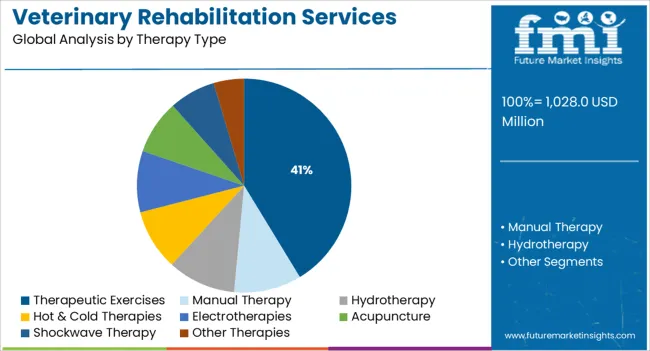
The therapeutic exercises segment is expected to contribute 41.30% of the overall market share by 2025 within the therapy type category, establishing it as the most significant segment. These exercises are essential for restoring functional movement, improving strength, and aiding coordination following surgery or injury.
Their non-invasive nature and adaptability to various conditions make them a preferred choice in rehabilitation protocols. Customizable routines based on the specific condition of the animal allow for progressive improvement and measurable outcomes, making this approach popular among veterinary professionals.
Increased education and training among practitioners, along with greater availability of exercise-focused rehabilitation programs, have further bolstered adoption. As therapeutic exercises demonstrate consistent clinical benefits, they continue to play a central role in comprehensive rehabilitation strategies.
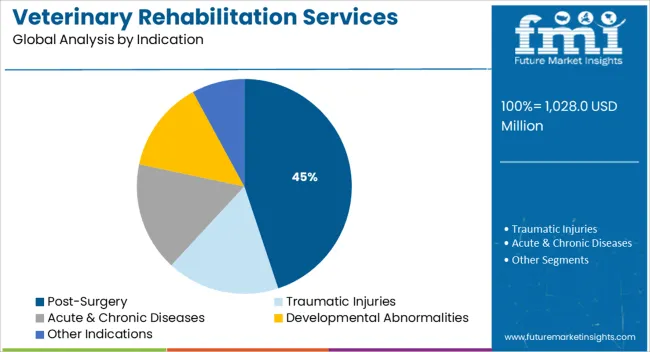
The post surgery segment is projected to represent 44.90% of the total market revenue by 2025 within the indication category, making it the top application segment. This growth is being driven by the rising volume of orthopedic and neurological surgeries among pets and the critical need for structured rehabilitation to ensure optimal recovery.
Post surgical care through rehabilitation helps reduce inflammation, restore mobility, and shorten recovery timelines, leading to better clinical outcomes. Veterinarians increasingly recommend rehabilitation as a standard component of post operative care to improve functionality and prevent secondary complications.
Pet owners are becoming more proactive in seeking post surgery rehabilitation services to enhance their pets’ long-term mobility and comfort. This trend reinforces the segment’s leadership in the overall market.
The Veterinary rehabilitation services market was valued at around USD 666.3 Million in 2020 while possessing a CAGR of 9.9% during the historical period. The rising pet population increased expenditure on companion animals, and growth in veterinary infrastructure are propelling the growth of this market.
These factors are providing thrust for the expansion of the veterinary rehabilitation market. Considering these factors, the Global veterinary rehabilitation services market will reach a market valuation of USD 2.1 Billion with a remarkable CAGR of 9.06% during the forecast period.
Pet humanization fuelling the market growth of veterinary rehab services
The increasing number of companion animals & pet humanization trends, the rising prevalence of musculoskeletal & orthopedic disorders among animals, and rising awareness among pet owners regarding physical rehabilitation as non-invasive & drug-free treatment are some of the key factors driving this market.
In addition, with the growing number of people valuing wildlife conservation, the count of volunteer rehabilitators who rescue and protect wounded/injured wildlife animals is also increasing. For instance, according to a study published in March 2025, by the National Library of Medicine, millions of native animals are rescued, rehabilitated, and protected by wildlife rehabilitators each year globally.
Expensive veterinary rehab services to restrain the market expansion
The high cost of veterinary rehab services and the shortage of skilled personnel are anticipated to hinder the growth of the global veterinary rehabilitation services market. The cost of diagnostic imaging equipment and veterinary drugs is high, which has led to the high cost of veterinary services.
Lack of awareness in developing or under-developed economies is anticipated to hamper the growth of the global veterinary rehabilitation services market. For instance, cats and dogs are the two most common household companion animals that can be a direct or indirect source of zoonotic infections. These factors will pose challenges to market growth.
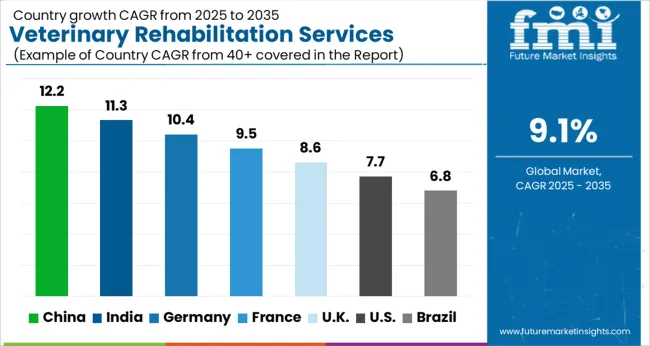
North America dominated the veterinary rehabilitation services market and accounted for a revenue share of over 35.1% in 2025. The high share of the region is due to the significant presence of veterinary rehabilitation centers, increasing awareness among pet owners regarding physical rehab services, rising therapy availability, and increasing pet ownership & veterinary expenditure.
The growing number of veterinary hospitals with trained and licensed veterinarians who also offer rehabilitation services is another factor boosting the market growth. According to the American Veterinary Medical Association, over 110,000 registered veterinarians were estimated in the USA in 2024, majorly offering services to small animal patients. According to APPA many of these registered veterinarians are currently certified to provide rehabilitation for companion animals.
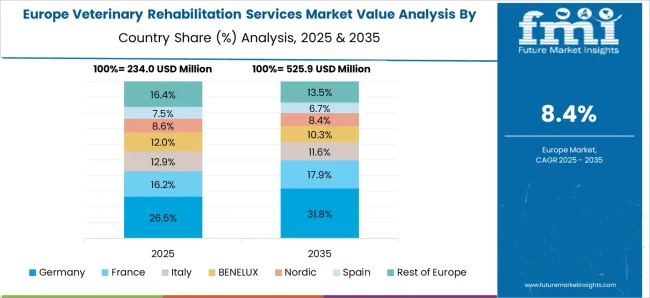
Europe region holds the second-largest share of the market. This is due to the rising number of wildlife rehabilitation centers and shelter homes in European countries. The growth is also fueled by the rising per capita income and the treatment of pets as a family member.
The Asia Pacific region is expected to grow fast with a market share of 13% in 2025. This is attributable to the increasing disposable income & veterinary services expenditure in key markets and growing awareness about pet rehab services in developing countries. The growing demand for proper and timely rehabilitation for companions to relieve their painful conditions, and pet humanization in developing countries like India is further boosting the growth of the market.
Asia-Pacific is predicted to remain veterinary pain management's fastest-growing market due to increased government measures to promote awareness, a rise in medical tourism, growing research activities in the region, a rising pet population, and growing demand for better healthcare in the region.
The companion animal segment is anticipated to dominate the market and account for the largest revenue share of around 70% by 2035. Increasing pet ownership rates especially in developed regions, rising pet healthcare services expenditure, growing incidence of chronic orthopedic conditions and widely arising physical rehabilitation requirements are among the factors responsible for the largest share of the segment.
In addition, the growing population rate of dogs in every region further propels the market’s growth. According to the AKC (American Kennel Club), the number of USA households owning dogs reached 942.6 million (54%) in 2024 which increased from 50% in 2020. Similarly, in Europe, nearly 90 million households (46%) own at least one pet, according to FEDIAF European Pet Food Industry in 2024. In addition, the COVID-19 pandemic has encouraged most people in the world to adopt pets for psychological comfort.
The therapeutic exercises segment dominated the market and accounted for the largest revenue share of over 20.3% in 2024. Therapeutic or guided exercises are one of the most frequently used physical rehabilitation therapy for companion animals such as dogs. Veterinary therapeutic exercise programs comprise balance therapies, weight shifting, weight loss therapies, and several other exercises using grounded treadmills, cavalletti rails, balance discs, and peanut balls among others.
These exercises improve the body mobility, strength, flexibility, and endurance of animals that have chronic conditions such as arthritis, or those recovering from debilitating musculoskeletal or orthopedic surgery. In addition, for animal patients with neurological conditions, physical rehab exercises catalyze their healing process and speed up the return to normal physic, and promote overall energy and health.
The post-surgery segment dominated the market and accounted for the largest market share of 31% in 2025. This substantial share is due to the growing number of orthopedic surgeries performed for dogs and cats, with the increasing number of veterinarians directing pets toward rehabilitation centers after surgery.
Orthopedic surgeries for companion animals are one of the common procedures that veterinarians perform to treat musculoskeletal issues. Post-operative patients are more likely to consider rehabilitation to reduce inflammation & pain and to improve the healing rate. Physical rehabilitation therapy after surgery has become more common in the veterinary field with newer advancements, which further contributes to segmental growth.
The veterinary rehab centers and hospitals segment dominated the market and accounted for the largest market share of over 45.8% in 2025. This is due to a growing number of veterinary rehab hospitals and centers globally with advanced infrastructures. These centers are very critical for veterinary rehabilitation services as they provide professional therapies with certified veterinary rehabilitators.
The increasing number of veterinary rehab professionals is another factor driving the segment growth in the market. According to the American Animal Hospital Association (AAHA), currently, many veterinary technicians and normal veterinarians are certified to rehabilitate animal patients in veterinary general hospitals. These affirmative factors are contributing to the segmental growth over the forecast period.

The global veterinary rehabilitation services market is consolidated with few large and medium-sized players accounting for most of the market revenue. Major players are deploying various strategies, entering into mergers and acquisitions, strategic agreements and contracts, developing testing, and introducing more effective veterinary rehabilitation services solutions. Some of the major company profiles included in the global veterinary rehabilitation services market report are-
Back on Track Veterinary Rehabilitation Center LLC, Animal Acupuncture and Rehabilitation Center, BARC, Treasure Coast Animal Rehab & Fitness, Animal Rehab Center of Michigan, Blue Springs Animal Rehabilitation Center, Essex Animal Hospital, Triangle Veterinary Referral Hospital, Butterwick animal rehab clinic Ltd, Animal Rehab and Conditioning Center.
| Report Attribute | Details |
|---|---|
| Market Value in 2025 | USD 1028.0 million |
| Market Value in 2035 | USD 2447.1 million |
| Growth Rate | CAGR of 9.06% from 2025 to 2035 |
| Base Year for Estimation | 2025 |
| Historical Data | 2020 to 2025 |
| Forecast Period | 2025 to 2035 |
| Quantitative Units | Revenue in USD Million and Billion and CAGR from 2025 to 2035 |
| Report Coverage | Revenue Forecast, Volume Forecast, Company Ranking, Competitive Landscape, Growth Factors, Challenges, Trends, and Pricing Analysis |
| Segments Covered | Animal Type, Therapy Type, Indication, End-Use, Region |
| Regions Covered | North America; Latin America; Europe; East Asia; South Asia; Oceania; Middle East and Africa(MEA) |
| Key Countries Profiled | USA, Canada, Brazil, Mexico, Germany, United Kingdom, France, Spain, Italy, India, Malaysia, Singapore, Thailand, Australia, New Zealand, China, Japan, South Korea, GCC countries, Malaysia, Singapore, Thailand, South Africa, Israel |
| Key Companies Profiled | Back on Track Veterinary Rehabilitation Center, LLC; Animal Acupuncture and Rehabilitation Center; BARC; Treasure Coast Animal Rehab & Fitness; Animal Rehab Center of Michigan; Blue Springs Animal Rehabilitation Center; Essex Animal Hospital; Triangle Veterinary Referral Hospital; Butterwick Animal Rehab Clinic Ltd; Animal Rehab and Conditioning Center |
| Customization | Available Upon Request |
The global veterinary rehabilitation services market is estimated to be valued at USD 1,028.0 million in 2025.
The market size for the veterinary rehabilitation services market is projected to reach USD 2,447.1 million by 2035.
The veterinary rehabilitation services market is expected to grow at a 9.1% CAGR between 2025 and 2035.
The key product types in veterinary rehabilitation services market are companion animals, wildlife animals and production animals.
In terms of therapy type, therapeutic exercises segment to command 41.3% share in the veterinary rehabilitation services market in 2025.






Full Research Suite comprises of:
Market outlook & trends analysis
Interviews & case studies
Strategic recommendations
Vendor profiles & capabilities analysis
5-year forecasts
8 regions and 60+ country-level data splits
Market segment data splits
12 months of continuous data updates
DELIVERED AS:
PDF EXCEL ONLINE
Veterinary Point of Care Diagnostics Market Size and Share Forecast Outlook 2025 to 2035
Veterinary Allergy Diagnostics Market Size and Share Forecast Outlook 2025 to 2035
Veterinary TSE Testing Market Size and Share Forecast Outlook 2025 to 2035
Veterinary Dermatology Market Forecast Outlook 2025 to 2035
Veterinary Telemedicine Market Size and Share Forecast Outlook 2025 to 2035
Veterinary Dietary Supplements Market Size and Share Forecast Outlook 2025 to 2035
Veterinary Imaging Market Forecast and Outlook 2025 to 2035
Veterinary CRISPR-Based Detection Kits Market Size and Share Forecast Outlook 2025 to 2035
Veterinary Pregnancy Test Kit Market Forecast and Outlook 2025 to 2035
Veterinary X-Ray Illuminators Market Size and Share Forecast Outlook 2025 to 2035
Veterinary Scales Market Size and Share Forecast Outlook 2025 to 2035
Veterinary Grooming Aids Market Size and Share Forecast Outlook 2025 to 2035
Veterinary Micro-fibre Endoscope Market Size and Share Forecast Outlook 2025 to 2035
Veterinary Faecal Filters Market Size and Share Forecast Outlook 2025 to 2035
Veterinary Dental Equipment Market Size and Share Forecast Outlook 2025 to 2035
Veterinary Rapid Test Market Size and Share Forecast Outlook 2025 to 2035
Veterinary Therapeutic Diet Market Size and Share Forecast Outlook 2025 to 2035
Veterinary Glucometers Market Size and Share Forecast Outlook 2025 to 2035
Veterinary Pain Management Drugs Market Size and Share Forecast Outlook 2025 to 2035
Veterinary Anesthesia Machines Market Size and Share Forecast Outlook 2025 to 2035

Thank you!
You will receive an email from our Business Development Manager. Please be sure to check your SPAM/JUNK folder too.
Chat With
MaRIA